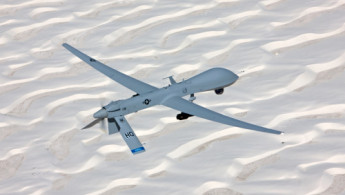Secret US military unit 'killed civilians' in anti-IS operations in Syria, Iraq
A highly classified American strike cell launched tens of thousands of attacks against the Islamic State group in Syria and Iraq, repeatedly killing civilians in the process, according to multiple US military and intelligence officials.
The top-secret unit - known as Talon Anvil - worked around the clock out from innocuous offices in Syria and Iraq between 2014 to 2019.
Former staff told The New York Times that the unit frequently broke international laws in place to protect civilians and non-combatants.
"They were ruthlessly efficient and good at their jobs," said one former Air Force intelligence officer who worked on hundreds of classified Talon Anvil missions from 2016 to 2018. "But they also made a lot of bad strikes."
The US Army had labelled the war on IS in Syria and Iraq as the most precise and humane in military history. However, Former Department of Defence and Pentagon adviser Larry Lewis said that civilian casualties from IS operations were ten times higher in Syria than in similar missions in Afghanistan.
The secret cell was run by approximately 20 low-level operatives who oversaw drone operations in which civilian deaths rose steadily year on year, alarming intelligence officials back in the US.
Former staffers allege a shoddy and unprofessional work culture in the unit, noting how "they [operators] worked on a first-name basis, went to work in shorts and casual footwear like Crocs and Birkenstocks and often sported bushy beards".
Military whistleblowers told the New York Times that pilots would refuse to drop 500-pound bombs on targets in densely populated areas. Some within the top secret unit Talon Anvil even "refused to participate in strikes."
— Kevin Gosztola (@kgosztola) December 12, 2021
When they complained to superiors, they were ignored. pic.twitter.com/E7CCrF56ia
Talon Anvil circumvented internal military rules on the need to verify evidence or confirm targets by claiming its strikes were made in "self-defence". This allowed them to operate faster and without oversight.
Footage from drone strikes is normally stored by the US military to assess damage. However, Talon Anvil had a pattern of turning drone cameras away at key moments “as if hit by a wind gust”, an Air Force officer told the Times.
In one incident, recalled by the same officer, Talon Anvil deployed a Predator drone to the Syrian farming town of Karama. One of the operators, posting on a chat shared with Air Force intelligence based in the US, said: "All civilians have fled the area. Anyone left is an enemy fighter. Find lots of targets for us today because we want to go Winchester."
Going Winchester means expending all the drone’s missiles and 500-pound bombs.
The operator proceeded to drop a 500-pound bomb on the town and ordered a "self-defence" strike on a single building. Watching in high definition as civilians "staggered out of the partly collapsed building, some missing limbs, some dragging the dead", the operator proceeded to launch a second strike.
No record of the killings at Karama exists in the US Army’s public reports on civilian casualties, however Airwars, a group of independent journalists that roughly tallies the death toll of air strikes in Middle Eastern countries, estimated that seven to 14 residents of Karama died that day, including six children.





 Follow the Middle East's top stories in English at The New Arab on Google News
Follow the Middle East's top stories in English at The New Arab on Google News


